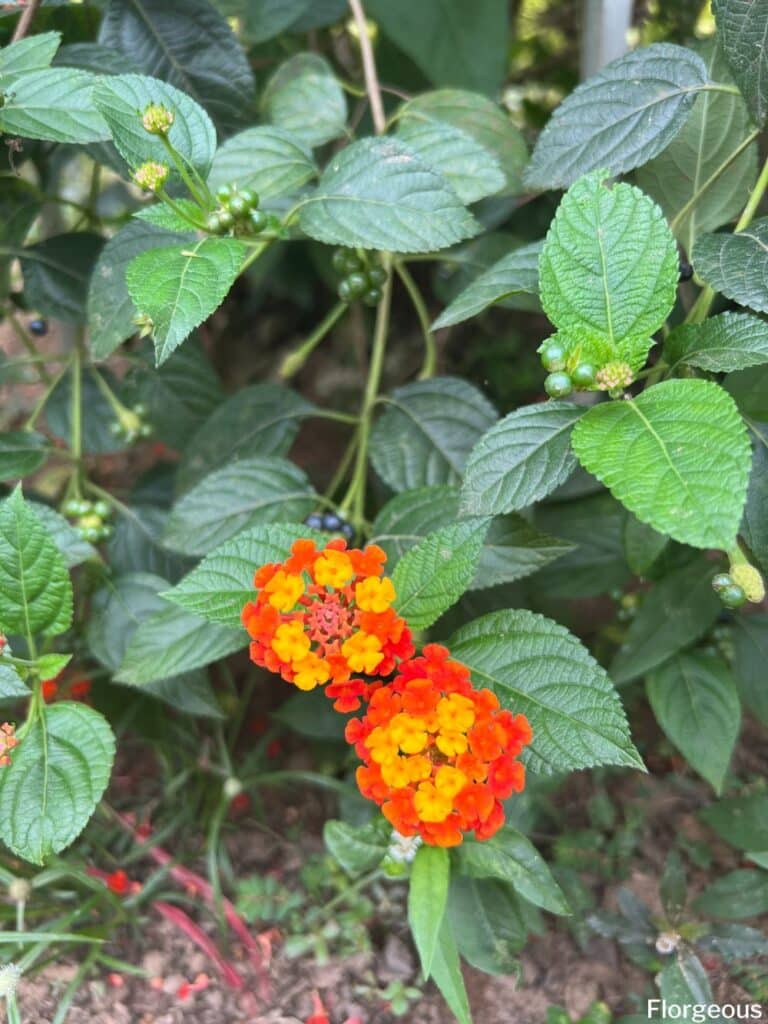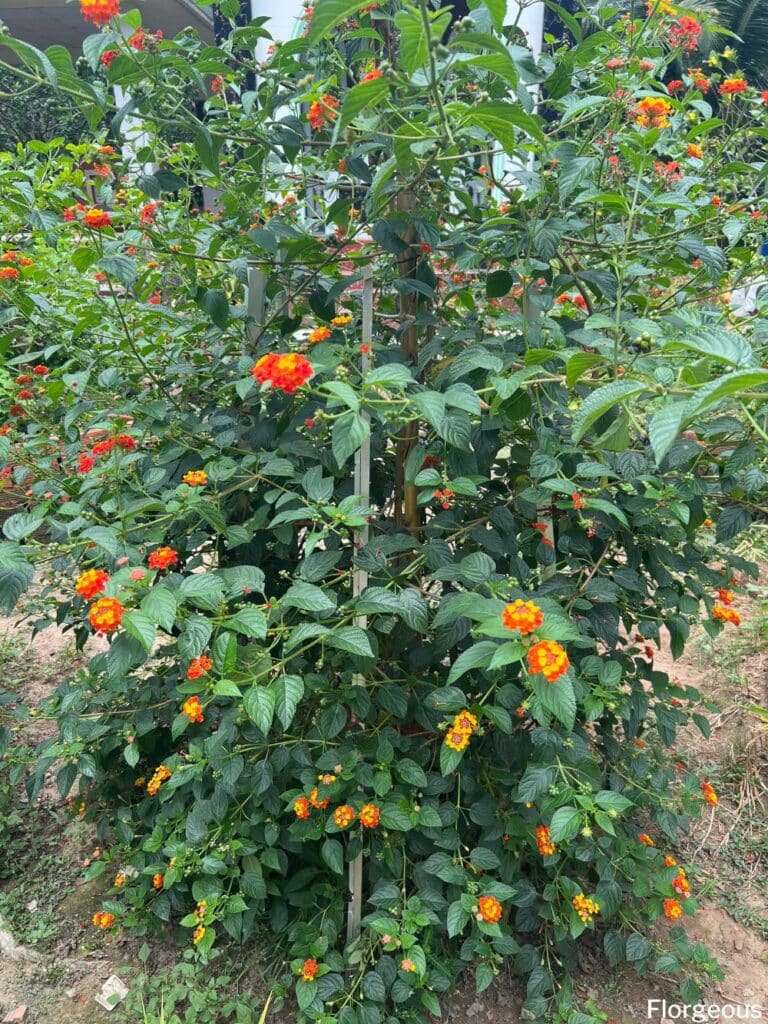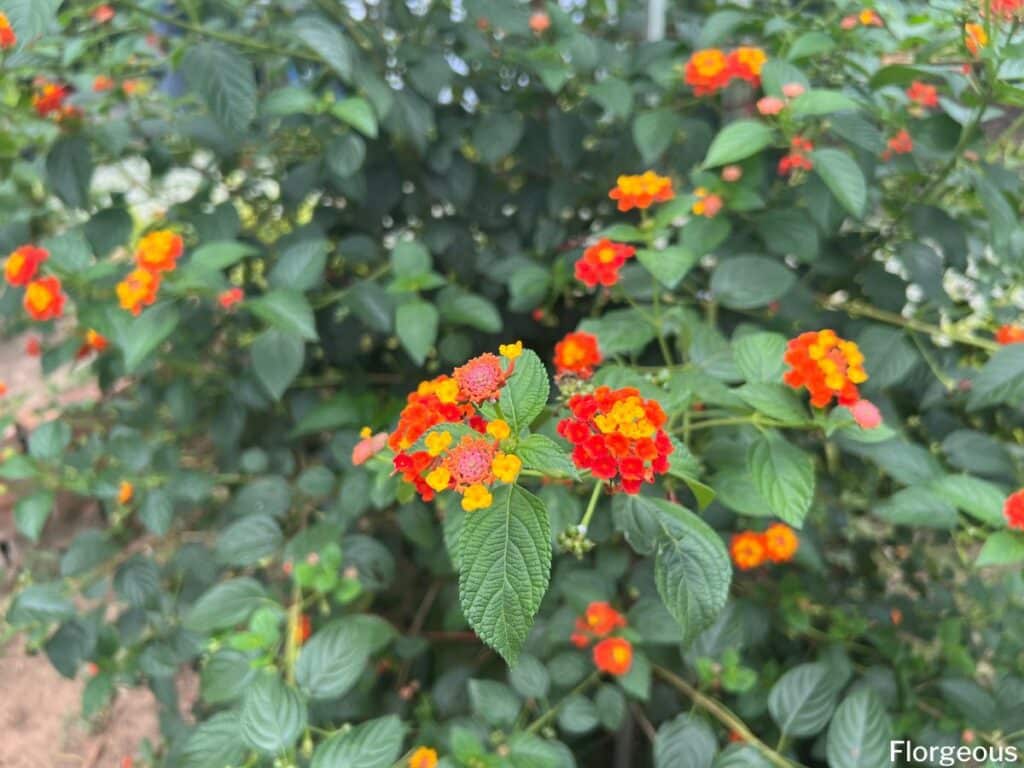Lantana is a beautiful flowering plant that’s native to tropical regions across the world – and it’s a mostly effortless plant to maintain.
With vibrant hues and fragrant blooms, lantana is a perfect addition to any garden.
If you’re new to gardening or a longtime plant enthusiast looking to add lantana to your collection, this guide will give you all the tips and tricks you need to grow and care for lantana like a pro.
Ready to get started with growing lantana? Here’s the ultimate guide on how to grow and care for lantana so you can start building the most beautiful garden today with these colorful flowers.
Lantana Plant Facts
| Scientific name | Lantana camara |
| Common names | Lantana, shrub verbena, Spanish flag, West Indian lantana, red salvia, common lantana |
| Family | Verbenaceae |
| Plant Type | Perennial Flower |
| Height and Width | 1–6 feet tall, 2–6 feet wide |
| Origin | The Americas, Africa, eastern Australia, and tropical regions of Asia |
| Flower colors | Red, orange, yellow, pink, purple, white, bi-color |
| Foliage color | Green, variegated |
| Sun Exposure | Full sun for best blooms, can tolerate partial shade |
| Soil Type & pH | Well-drained, slightly acidic soil with pH of 6.5–7.0 |
| Special features | Drought-tolerant, attracts butterflies and hummingbirds, low-maintenance, can be grown in containers |

How to Grow Lantana Flowers
Lantana camara is a broadleaf evergreen shrub that produces gorgeous flower clusters in the early spring – typically, it produces pink, yellow, orange, red, purple, or white flowers, depending on the variety.
A tender perennial, lantana is known for its ability to attract butterflies with its tubular flowers, and for its attractive green or variegated foliage. Lantana can be grown year-round in tropical and subtropical regions, but it’s best to plant in spring after the last frost in temperate regions. It prefers warm weather and can tolerate some drought.
When planting lantana plants, know they can grow in almost any soil type, as long as it’s well-drained. It’s ideal for gardens, borders, and rockeries, and makes an attractive ground cover too.
Lantana can be planted in pots, beds, or hanging baskets. Choose a spot with full sunlight or partial shade and make sure the soil is well-drained.
Here’s a guide to how to grow lantana flowers so you can get started ASAP with this lovely spreading plant.
Propagation
You can grow lantana via seeds, cuttings, or layering.
Just one or two seeds can take up to six weeks to germinate, so if you want faster results, consider taking cuttings or layering. To take a cutting, remove a 4-inch stem tip that has mature leaves and no flower buds. Dip the end in rooting hormone and plant it in a potting mix.
To grow lantana flowers by layering, bend a low-growing stem and bury it in soil, leaving the tip exposed. The stem will develop roots at the buried section and form new plants.
Soil
Lantana is tolerant of a variety of soil types, but it prefers well-draining soil (sandy soil in warm climates where it will be the most profuse bloomer). Adding coarse sand or gravel to the soil can aid in improving drainage for the plants. Lantana plants do not like heavy clay soil that retains too much moisture. If your soil conditions are too heavy, consider adding sand or perlite to improve drainage.
The optimal soil pH for growing lantana plants is between 6.0 to 7.5, which is neutral to slightly acidic. Adding pine needles or a light dose of sulfur can help increase the acidity of the soil.
Pruning
Lantana blooms on new wood, meaning that it flowers on the current season’s growth. To encourage bushier growth and more blooms (and to get enough light into the plants), lightly prune the plants regularly throughout the growing season. You can prune up to one-third of the plant at a time to encourage branching.
Cut back the stems to just above a leaf node or side-branch. Deadheading – removing spent flowers – can also help prolong the blooming period and prevent self-seeding.
Repotting and Transplanting
Lantana plants can become root-bound in pots and will need to be repotted every two to three years.
To repot, gently loosen the root ball and place the plant in a container that is slightly larger than the current one. Add high quality potting soil and water well. If transplanting from a pot to the ground, make sure to prepare the soil as mentioned above.
Dig a hole that is slightly larger than the root ball and gently lift the plant out of the pot. Place it in the hole and backfill with soil. Water well and add mulch around the base of the plant.

How to Care for Lantana Plants
Regardless of whether you are growing your lantana flowers in hanging baskets, in containers, or directly in the ground when grown outdoors, these lantana care tips will help your flowering lantana plants thrive in any setting.
Water
Lantana plants are relatively drought-tolerant, but they still need some water to grow and flower. The trick is to provide them with enough moisture without overwatering them.
Generally, you should water your lantana plants once a week, or more often during hot and dry weather. Make sure to water deeply and thoroughly, so that the water reaches the roots instead of just wetting the surface of the soil.
Sunlight
Lantana plants love sunlight, and they need at least six hours of full sun daily to bloom well.
However, they can also tolerate some shade, especially during the hottest part of the day.
If you’re growing some lantana in a container or window boxes, make sure to plant lantanas in a sunny spot that’s sheltered from strong winds and frost – and remember, too much shade can limit the plant from putting on new growth.
When choosing companion plants for lantana, make sure they have similar sunlight requirements and growing conditions.
Temperature and Humidity
Lantanas are native to tropical regions, so they prefer warmer climates and a sunny location. They can tolerate some cold and drought, but they may suffer from frost damage or die if exposed to temperatures below 25 degrees Fahrenheit.
To protect your lantana from frost, you can cover it with a blanket or move it into a sheltered spot.
You can increase the humidity around your lantana by misting it with water or placing a tray of water near it.
Fertilizer
Lantanas don’t require a lot of fertilizer, but they can benefit from a balanced, slow-release formula that provides essential nutrients such as nitrogen, phosphorus, and potassium.
You can apply fertilizer to your lantana once a month during the growing season but be wary of applying too much fertilizer, as this can harm these flowering shrubs as well.
Pest and diseases
While it’s a relatively tough, hardy plant, lantana is prone to pests and diseases that can damage its appearance and health. Here are some to watch out for.
Lace Bugs
Lace bugs are tiny insects that suck the sap from the undersides of lantana leaves, causing small yellow or brown spots. The damage can spread quickly, ruining the beauty and health of the plant. A natural remedy is to plant herbs like sage, thyme, or catnip near your lantanas, as they repel these pests.
Root Rot
Poor drainage is the main cause of this issue in lantanas. When the soil stays too wet for too long, the roots rot and the plant cannot absorb nutrients and water properly. To prevent root rot, make sure that the soil has proper drainage and that you are not overwatering your lantanas.
Spider Mites
Mites are common pests that can cause the leaves of your lantanas to turn yellow or brown with tiny webs. These pests multiply quickly in hot and dry weather. To control spider mites, you can use predatory mites, such as Phytoseiulus persimilis, which will feed on the pests without harming your plant. You can also use insecticidal soap or neem oil.
Common Varieties and Cultivars
Lantanas come in various colors and sizes and can be classified into three groups – compact, spreading, and upright. Let’s start by discussing the popular varieties of compact lantanas, which grow up to 3 feet tall and wide.
‘New Gold’ is the most common compact cultivar, with its alluring clusters of yellow flowers that bloom profusely from late spring to fall. If you’re looking for a more subtle shade, try ‘Landmark Peach Sunrise,’ which greets you with soft peach-colored flowers and deep green foliage.
If you want your lantana to spill over the edge of a container or garden bed, then spreading varieties are the way to go. ‘Radiation,’ a commonly grown spreading cultivar, keeps your garden vibrant with its cheerful blossoms of red and orange.
For a show-stopping display, choose the upright varieties of lantanas, which can reach up to 6 feet in height. ‘Patriot Rainbow’ is a popular choice, with its multicolored blooms in shades of orange, pink, and yellow.
Now, let’s talk about a unique cultivar that’s all the rage with gardeners – lantana with a trailing habit. Trailing lantana varieties can reach up to 5 feet long and hang elegantly over a wall or container. ‘Trailing Lavender’ lantana, with its clusters of lavender flowers and rich green leaves, is a must-have for anyone who loves pastel shades.
Some other types of lantana to consider growing include:
- Popcorn Lantana (Lantana trifolia)
- Luscious Grape (Lantana montevidensis)
- Miss Huff
- Dallas Red
- Radiation
Conclusion
There you have it! Everything you need to know about growing lantana flowers – easy peasy. Lantana thrives in direct sunlight and well drained soil in frost free climates, but with a little care, you can grow these tender perennials in all kinds of settings. Even if you live in one of the country’s colder climates, you can enjoy this beautiful plant in containers – so get started today!
Check this guide about lantana flower meaning to see why people love growing these flowers.







